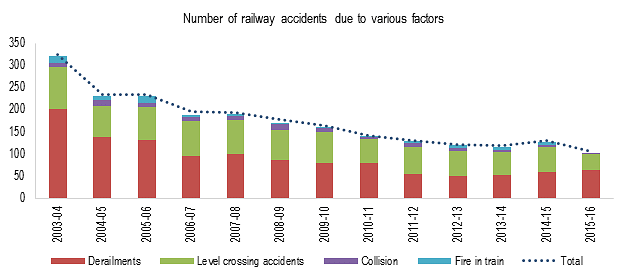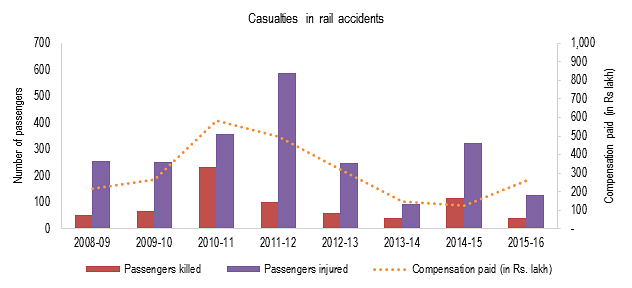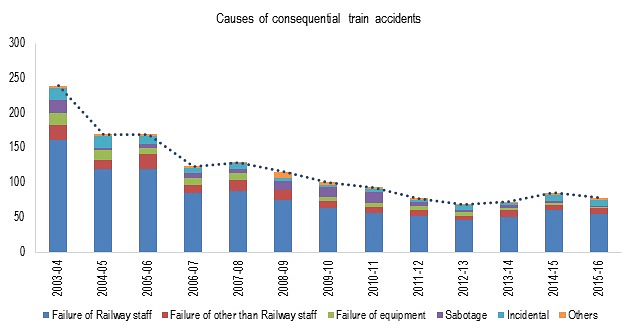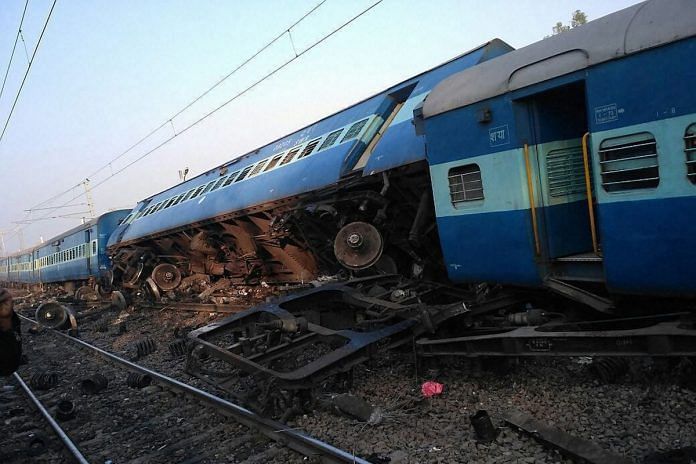Safety has been one of the biggest concerns in the Indian Railways system. While the number of accidents have gone down over the last few years, the number still remains over 100 accidents a year. In light of the accident Friday in which the Vasco Da Gama-Patna Express derailed, killing at least three, here’s an analysis of what causes so many accidents.
Causes of rail accidents
The number of rail accidents has declined from 325 in 2003-04 to 106 in 2015-16. The number of rail accidents as per the cause are shown in the graph below. In 2015-16, majority of the accidents were caused due to derailments (60 per cent), followed by accidents at level crossings (33 per cent).
In the last decade, accidents caused due to both these causes have reduced by about half. According to news reports, the recent railway accidents in UP were caused due to derailment of coaches.

Derailments
Between 2003-04 and 2015-16, derailments were the second highest reason for casualties. The Standing Committee on Railways, when examining the safety in railways, had noted that one of the reasons for derailments is defect in the track or coaches. Of the total track length of 1,14,907 kms in the country, 4,500 kms should be renewed annually.
However, in 2015-16, of the 5,000 km of track length due for renewal, only 2,700 km was targeted to be renewed. The Committee had recommended that Indian Railways should switch completely to the Linke Hoffman Busch (LHB) coaches as they do not pile upon each other during derailments and hence cause lesser casualties.
Un-manned level crossings
Un-manned level crossings (UMLCs) continue to be the biggest cause of casualties in rail accidents. Currently there are 14,440 UMLCs in the railway network. In 2014-15, about 40 per cent of the accidents occurred at UMLCs, and in 2015-16, about 28 per cent. Between 2010 and 2013, the Ministry fell short of meeting their annual targets to eliminate UMLCs. Further, the target of eliminating 1,352 UMLCs was reduced by about 50 per cent to 730 in 2014-15, and 820 in 2015-16.
Implementation of audio-visual warnings at level crossings has been recommended to warn road users about approaching trains. These may include Approaching Train Warning Systems, and Train Actuated Warning Systems. The Union Budget 2017-18 proposes to eliminate all unmanned level crossings on broad gauge lines by 2020.
Casualties and compensation
In the last few years, Railways has paid an average compensation of Rs 3.03 crore every year for accidents (see figure below).

Note: Compensation paid during a year relates to the cases settled and not to accidents/casualties during that year.
Consequential train accidents
Accidents in railways may or may not have a significant impact on the overall system. Consequential train accidents are those which have serious repercussions in terms of loss of human life or injury, damage to railway property or interruption to rail traffic. These include collisions, derailments, fire in trains, and similar accidents that have serious repercussions in terms of casualties and damage to property. These exclude cases of trespassing at unmanned railway crossings.
As seen in the figure below, the share of failure of railways staff is the biggest cause of consequential rail accidents. The number of rail accidents due to failure of reasons other than the railway staff (sabotage) has increased in the last few years.

Accidents due to failure of railway staff
It has been noted that more than half of the accidents are due to lapses on the part of railway staff. Such lapses include carelessness in working, poor maintenance, adoption of short-cuts, and non-observance of laid down safety rules and procedures. To address these issues, conducting a regular refresher course for each category of railway staff has been recommended.
Accidents due to loco-pilots
Accidents also occur due to signalling errors for which loco-pilots (train-operators) are responsible. With rail traffic increasing, loco-pilots encounter a signal every few kilometres and have to constantly be on high alert. Further, currently no technological support is available to the loco-pilots and they have to keep a vigilant watch on the signal and control the train accordingly.
These loco-pilots are over-worked as they have to be on duty beyond their stipulated working hours. This work stress and fatigue puts the life of thousands of commuters at risk and affects the safety of train operations. It has been recommended that loco-pilots and other related running staff should be provided with sound working conditions, better medical facilities and other amenities to improve their performance.
Actions taken by Railways with regard to the recent train accident
According to news reports, the August 2017 accident of Utkal Express in UP resulted in 22 casualties and over 150 injuries. It has also been reported that following this incident, the Railways Ministry initiated action against certain officials (including a senior divisional engineer), and three senior officers (including a General Manager and a Railway Board Member).
The Committee on Restructuring of Railways had noted that currently each Railway zone (headed by a General Manager) is responsible for operation, management, and development of the railway system under its jurisdiction. However, the power to make financial decisions does not rest with the zones and hence they do not possess enough autonomy to generate their own revenue, or take independent decisions.
While the zones prepare their annual budget, the Railway Board provides the annual financial budget outlay for each of them. As a result of such budgetary control, the GM’s powers have been reduced leaving them with little independence in planning their operations.
The Committee recommended that the General Managers must be fully empowered to take all necessary decisions independent of the Railway Board. Zonal Railways should also have full power for expenditure and re-appropriations and sanctions. This will make each Zonal Railway accountable for its transport output, profitability and safety under its jurisdiction.
Under-investment in railways leading to accidents
In 2012, a Committee headed by Anil Kakodkar had estimated that the total financial cost of implementing safety measures over the five-year period (2012-17) was likely be around Rs one lakh crore. In the Union Budget 2017-18, the creation of a Rashtriya Rail Sanraksha Kosh was proposed for passenger safety. It will have a corpus of Rs one lakh crore, which will be built over a five-year period (Rs 20,000 crore per year).
The Standing Committee on Railways had noted that slow expansion of rail network has put undue burden on the existing infrastructure leading to severe congestion and safety compromises. Since independence, while the rail network has increased by 23 per cent, passenger and freight traffic over this network has increased by 1,344% and 1,642% respectively.
This suggests that railway lines are severely congested. Further, under-investment in the sector has resulted in congested routes, inability to add new trains, reduction of train speeds, and more rail accidents. Therefore, avoiding such accidents in the future would also require significant investments towards capital and maintenance of rail infrastructure.
Prachee Mishra is a senior analyst at PRS Legislative Research.
This article was first published on the PRS blog and has republished here with permission.



